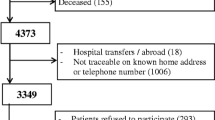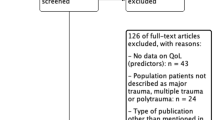Abstract
Purpose
To study how the health-related quality of life (HRQOL) of survivors of penetrating trunk trauma (PTT) changes from pre-morbid status to 6 months after hospital discharge and to determine differences in the HRQOL between subjects ventilated for short and prolonged periods of time. To determine how the HRQOL of PTT survivors compares with that of a healthy control group in order to identify limitations imposed by critical illness.
Methods
Retrospective and observational prospective assessment of the quality of life (QoL) of PTT survivors with the Medical Outcomes Short Form-36 (SF-36) UK English version questionnaire. Cross-sectional assessment of the QoL of a healthy control group with the SF-36.
Results
The physical component summary (PCS) score was significantly reduced for the short mechanical ventilation (MV) group (n = 13) at 1 and 3 months compared to pre-admission status (p = 0.00, respectively). The mental component summary (MCS) score was significantly reduced at 1, 3 and 6 months (p = 0.00, respectively). The PCS and MCS were significantly reduced for the long MV group (n = 29) at all three assessments compared to the pre-admission HRQOL (p = 0.00–0.01). The short MV group reported HRQOL comparable to that of the healthy group (n = 40) at 6 months after discharge. The long MV group had a significant reduction in the PCS at 1, 3 and 6 months compared to the healthy group (p = 0.00, respectively). The long MV group had significantly reduced PCS at 3 and 6 months compared to the short MV group (p = 0.01 and 0.00, respectively).
Conclusions
Subjects who had higher morbidity and prolonged MV suffered from reduced HRQOL related to physical health for up to 6 months after discharge.


Similar content being viewed by others
References
Statistics South Africa (2008). Mortality and causes of death in South Africa, 2006: Findings from death notification. Available online at: http://www.statssa.gov.za/publications/P03093/P030932006.pdf. Accessed 17 May 2010.
National Injury Mortality Surveillance System (2005). A profile of fatal injuries in South Africa: 7th annual report. Available online at: http://www.sahealthinfo.org.za/violence/national2005.pdf. Accessed 17 May 2010.
Bowley DM, Dickson EJ, Tai N, Goosen J, Boffard KD. A theme issue by, for, and about Africa: South Africa is still blighted by trauma. BMJ. 2005;331:780.
Wilson RF, Bender JS. General considerations in abdominal trauma. In: Wilson RF, Walt AJ, editors. Management of trauma: pitfalls and practice. 2nd ed. Baltimore: Williams & Wilkins; 1996. p. 424–9.
Boffard KD. Metabolic response to trauma. In: Mieny CJ, Mennen U, editors. Principles of surgical patient care. 2nd ed. Claremont: New Africa Education; 2003. p. 170–8.
Nordhaug D, Steensrud T, Aghajani E, Korvald C, Myrmel T. Nitric oxide synthase inhibition impairs myocardial efficiency and ventriculo-arterial matching in acute ischemic heart failure. Eur J Heart Fail. 2004;6(6):705–13.
Schiller HJ, Anderson HL III. Hemorrhagic shock and other low preload states. In: Lanken PN, editor. The intensive care unit manual. Pennsylvania: WB Saunders; 2001. p. 85–92.
Griffiths RD, Jones C. ABC of intensive care: recovery from intensive care. BMJ. 1999;319:427–9.
Salter KL, Moses MB, Foley NC, Teasell RW. Health-related quality of life after stroke: what are we measuring? Int J Rehabil Res. 2008;31(2):111–7.
Kranciukaite D, Rastenyte D. Measurement of quality of life in stroke patients. Medicina (Kaunas). 2006;42(9):709–16.
World Health Organization (WHO). Constitution of the World Health Organization. Geneva: WHO; 1948. p. 1–2.
World Health Organization QOL Group. The World Health Organization Quality of Life Assessment (WHOQOL): position paper from the World Health Organization. Soc Sci Med. 1995;41:1403–9.
DeVon HA, Ferrans CE. The psychometric properties of four quality of life instruments used in cardiovascular populations. J Cardiopulm Rehabil. 2003;23:122–38.
Dowdy DW, Eid MP, Sedrakyan A, Mendez-Tellez PA, Pronovost PJ, Herridge MS, Needham DM. Quality of life in adult survivors of critical illness: a systematic review of the literature. Intensive Care Med. 2005;31:611–20.
Cuthbertson BH, Scott J, Strachan M, Kilonzo M, Vale L. Quality of life before and after intensive care. Anaesthesia. 2005;60:332–9.
Monzon-Torres BI, Ortega-Gonzalez M. Penetrating abdominal trauma. S Afr J Surg. 2004;42(1):11–3.
Bowley DM, Rein P, Cherry R, Vellema J, Snyman T, Boffard KD. Substance abuse and major trauma in Johannesburg. S Afr J Surg. 2004;42(1):7–10.
Badia X, Diaz-Prieto A, Gorriz MT, Herdman M, Torrado H, Farrero E, Cavanilles JM. Using the EuroQol-5D to measure changes in quality of life 12 months after discharge from an intensive care unit. Intensive Care Med. 2001;27:1901–7.
Niskanen M, Ruokonen E, Takala J, Rissanen P, Kari A. Quality of life after prolonged intensive care. Crit Care Med. 1999;27(6):1132–9.
Myhren H, Ekeberg Ø, Stokland O. Health-related quality of life and return to work after critical illness in general intensive care unit patients: a 1-year follow-up study. Crit Care Med. 2010;38(7):1554–61.
Garnacho-Montero J, Madrazo-Osuna J, García-Garmendia JL, Ortiz-Leyba C, Jiménez-Jiménez FJ, Barrero-Almodóvar A, Garnacho-Montero MC, Moyano-Del-Estad MR. Critical illness polyneuropathy: risk factors and clinical consequences. A cohort study in septic patients. Intensive Care Med. 2001;27:1288–96.
Tennilä A, Salmi T, Pettilä V, Roine RO, Varpula T, Takkunen O. Early signs of critical illness polyneuropathy in ICU patients with systemic inflammatory response syndrome or sepsis. Intensive Care Med. 2000;26:1360–3.
Winkelman C, Higgins PA, Chen YJK, Levine AD. Cytokines in chronically critically ill patients after activity and rest. Biol Res Nurs. 2007;8(4):261–71.
Jackman RW, Kandarian SC. The molecular basis of skeletal muscle atrophy. Am J Physiol Cell Physiol. 2004;287:C834–43.
Reid MB, Li YP. Tumor necrosis factor-α and muscle wasting: a cellular perspective. Respir Res. 2001;2:269–72.
Gosselink R, Bott J, Johnson M, Dean E, Nava S, Norrenberg M, Schönhofer B, Stiller K, van de Leur H, Vincent JL. Physiotherapy for adult patients with critical illness: recommendations of the European Respiratory Society and European Society of Intensive Care Medicine Task Force on Physiotherapy for Critically Ill Patients. Intensive Care Med. 2008;34:1188–99.
Wehler M, Geise A, Hadzionerovic D, Aljukic E, Reulbach U, Hahn EG, Strauss R. Health-related quality of life of patients with multiple organ dysfunction: individual changes and comparison with normative population. Crit Care Med. 2003;31(4):1094–101.
Jones C, Skirrow P, Griffiths RD, Humphris GH, Ingleby S, Eddleston J, Waldmann C, Gager M. Rehabilitation after critical illness: a randomized, controlled trial. Crit Care Med. 2003;31(10):2456–61.
Acknowledgments
The authors would like to thank the following institutions for funding this project: (a) Thuthuka Programme for Researchers in Training, National Research Foundation, South Africa; (b) Ellen Hodges Medical Faculty Research Endowment Fund of the University of the Witwatersrand, South Africa.
Conflict of interest
None.
Author information
Authors and Affiliations
Corresponding author
Rights and permissions
About this article
Cite this article
van Aswegen, H., Myezwa, H., Mudzi, W. et al. Health-related quality of life of survivors of penetrating trunk trauma in Johannesburg, South Africa. Eur J Trauma Emerg Surg 37, 419–426 (2011). https://doi.org/10.1007/s00068-010-0071-4
Received:
Accepted:
Published:
Issue Date:
DOI: https://doi.org/10.1007/s00068-010-0071-4




